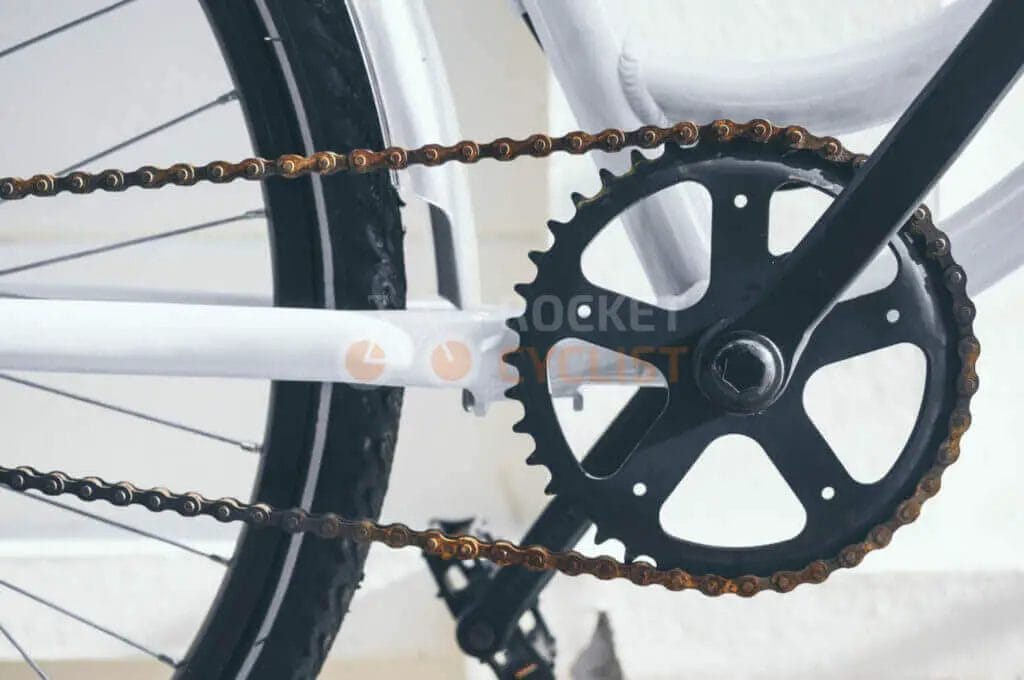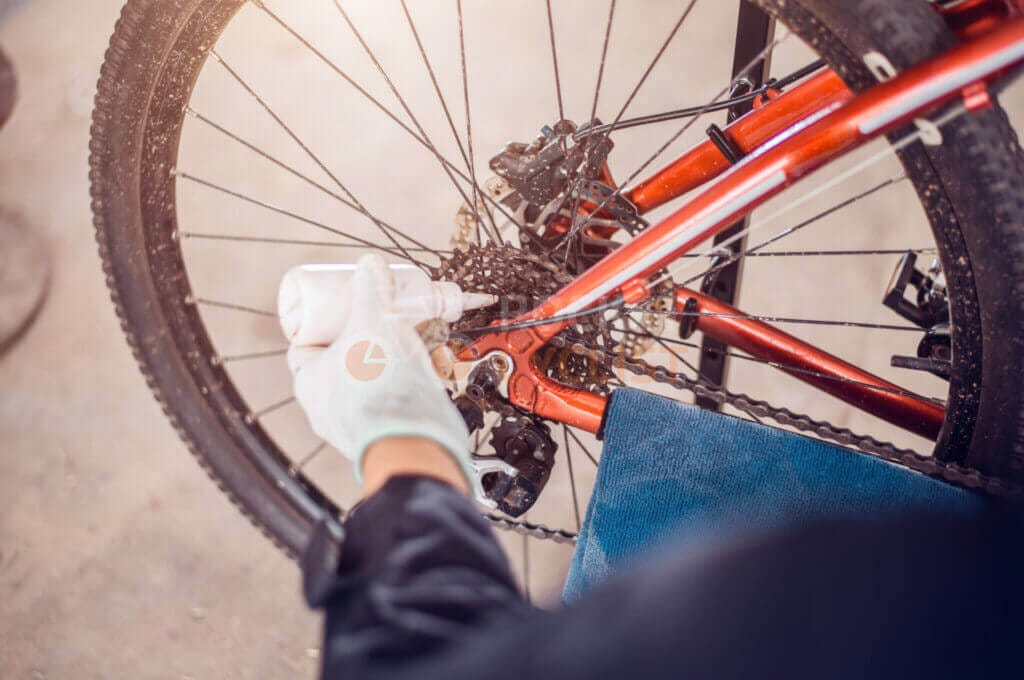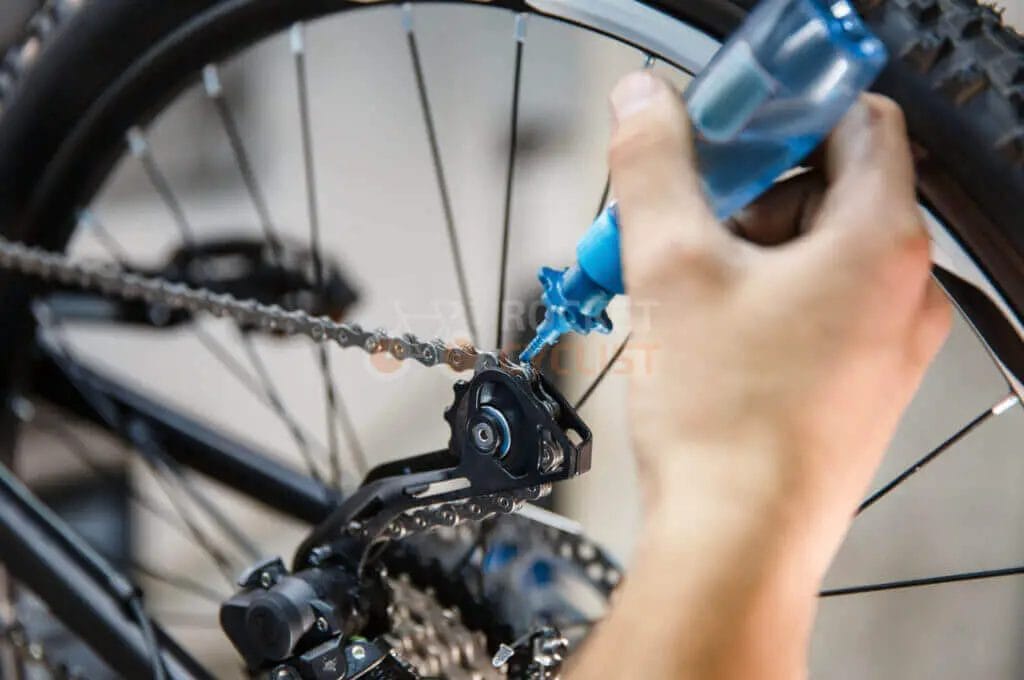Last Updated on March 27, 2024 by Vinson Lozano
A bicycle chain is a crucial component of any bike, as it transfers power from the pedals to the wheels. However, one common problem that many cyclists face is the rusting of their bicycle chain. Rust can lead to poor performance, increased wear and tear, and eventually, a broken chain. In this article, we will discuss the importance of preventing bicycle chain rust and provide some tips to keep your chain in top condition.

Importance of Preventing Bicycle Chain Rust
Preventing rust on your bicycle chain is essential for the following reasons:
- Enhanced Performance: Rust can cause friction and resistance in the chain, leading to a decrease in performance. A well-maintained chain will ensure a smooth and efficient cycling experience.
- Extended Lifespan: A rust-free chain will have a longer lifespan, saving you money on frequent replacements.
- Reduced Wear and Tear: When rust starts to eat away at the metal, it can weaken the chain, causing it to stretch and potentially break. Preventing rust will help preserve the integrity of the chain.
Why Rust Can Damage a Bicycle Chain

Rust can cause damage to your bicycle chain in several ways:
- Increased Friction: Rust creates rough surfaces on the chain, which increases friction. This can make pedaling more difficult and decrease your speed and efficiency.
- Chain Stretching: As rust eats away at the metal, it weakens the chain, causing it to stretch. A stretched chain can slip and even break during cycling.
- Poor Shifting: Rust can hinder the smooth movement of the chain across the gears, leading to poor shifting performance.
To prevent rust on your bicycle chain, make sure to clean and lubricate it regularly. Use a brush and mild detergent to remove dirt and grime, and then apply a bicycle-specific lubricant to protect it from moisture. Additionally, store your bike in a dry place, away from rain and humidity. By taking these simple steps, you can enjoy a rust-free bicycle chain and an improved cycling experience.
Clean and lubricate the chain regularly

Preventing rust on a bicycle chain is essential for maintaining a smooth and efficient ride. Regular cleaning and lubrication are key steps to keeping your chain in optimal condition. Here is a step-by-step guide to cleaning your bicycle chain:
Step-by-step guide to cleaning the chain:
- Start by removing the chain from your bike using a chain tool.
- Prepare a bucket of warm water with a gentle detergent or bike-specific chain cleaner.
- Dip a clean brush or sponge into the soapy water and gently scrub the chain to remove dirt, grime, and any rust that may have formed.
- Rinse the chain thoroughly with clean water to ensure all the soap and debris are removed.
- Dry the chain completely using a clean cloth or towel.
- Once the chain is dry, apply a lubricant specifically designed for bicycle chains. Be sure to use a rust-preventing lubricant for added protection.
- Apply a generous amount of lubricant to the chain, ensuring it penetrates each link.
- Allow the lubricant to sit on the chain for a few minutes, then wipe off any excess with a clean cloth.
- Reinstall the chain onto your bike and make sure it is properly tensioned and aligned.
Recommended lubricants for preventing rust:

To prevent rust on your bicycle chain, it’s important to use a lubricant that provides both lubrication and rust protection. Here are some recommended lubricants:
- WD-40 Bike Chain Lube: This lubricant is specifically formulated to repel water and prevent rust buildup on bicycle chains.
- Finish Line Wet Ceramic Lube: This high-performance lubricant contains ceramic particles and wetting agents to provide excellent corrosion protection.
- Pedro’s Chainj Chain Lube: Designed for all weather conditions, this lubricant boasts rust and corrosion inhibitors to keep your chain running smoothly.
- Boeshield T-9 Rust & Corrosion Protection Waterproof Lubricant: This lubricant creates a protective barrier on your chain, preventing rust even in wet conditions.
By following these cleaning and lubrication steps and using the recommended lubricants, you can prevent rust from forming on your bicycle chain, ensuring a longer lifespan and a smoother ride.
Remember to clean and lubricate your chain regularly, especially after riding in wet or muddy conditions. Happy cycling!
Store the bicycle in a dry environment

To prevent your bicycle chain from rusting, it’s essential to store your bicycle in a dry environment. Moisture and humidity are the primary culprits behind chain rust. Here are some tips on storing your bicycle indoors and protecting the chain from moisture and humidity:
Tips on storing the bicycle indoors:
- Find a cool and dry area: Choose a storage location that is away from direct sunlight and free from excessive moisture. Basements, garages, or dedicated bike storage spaces are ideal.
- Use a bike cover: Consider covering your bicycle with a breathable bike cover to protect it from dust, dirt, and potential moisture buildup in the surrounding environment.
- Hang the bike vertically or horizontally: When storing the bicycle indoors, hanging it vertically or horizontally can help keep the chain away from the floor and prevent contact with any dampness.
Protecting the chain from moisture and humidity:
- Apply chain lubricant: Regularly apply a chain lubricant to keep the chain well-oiled and protected from moisture. Be sure to choose a lubricant specifically designed for bicycles.
- Wipe down the chain after rides: After riding your bicycle in wet or damp conditions, take the time to clean and dry the chain thoroughly. Use a clean cloth to remove any excess moisture and dirt.
- Use rust prevention products: Consider using rust prevention products like rust inhibitors or corrosion-resistant sprays that can be applied to the chain to provide an extra layer of protection against rust.
Remember, prevention is key when it comes to keeping your bicycle chain rust-free. By following these tips, you can ensure that your bicycle chain remains in excellent condition and performs optimally for years to come.
Use rust-resistant chains or coatings

When it comes to preventing a bicycle chain from rusting, there are a few effective methods you can employ. One option is to invest in rust-resistant chains or apply rust-resistant coatings to your existing chain.
Both of these approaches can significantly extend the lifespan of your chain and ensure smooth and reliable performance. Let’s take a closer look at each method:
Choosing rust-resistant chains for bicycles
Investing in a rust-resistant chain can be a great preventive measure. Look for chains made from materials such as stainless steel or nickel-plated steel, as these materials have inherent corrosion resistance.
These chains are specifically designed to withstand exposure to moisture and the elements, reducing the risk of rust formation. Additionally, some chains come with special coatings that provide added protection against rust.
Applying rust-resistant coatings to the chain
If you already have a chain that is not rust-resistant, you can apply a rust-resistant coating to protect it. There are various rust-resistant coatings available on the market, such as wax-based lubricants and rust inhibitors. These coatings create a barrier between the chain and moisture, preventing rust from forming.
Before applying any coating, make sure to clean and degrease the chain thoroughly to ensure proper adhesion.
To summarize, here are the key features and details of preventing bicycle chain rust:
- Option 1: Choose rust-resistant chains made from stainless steel or nickel-plated steel.
- Option 2: Apply rust-resistant coatings such as wax-based lubricants or rust inhibitors.
- Rust-resistant chains and coatings extend the lifespan of the chain and prevent rust formation.
- Clean and degrease the chain before applying any coatings for optimal results.
Remember, regular maintenance and cleaning are also essential to prevent rust formation on your bicycle chain. By taking proactive measures and using rust-resistant chains or coatings, you can ensure the longevity and performance of your chain.
Keep the chain protected during rainy or wet conditions
Covering the chain during rainy rides
One of the best ways to prevent a bicycle chain from rusting during rainy or wet conditions is to cover it while riding. A chain cover, also known as a chain guard, can be installed to protect the chain from water and dirt. It is a simple and effective solution that can help prolong the life of your chain.
Drying and lubricating the chain afterward
After a wet ride, it is important to dry and lubricate the chain to prevent rust from forming. Here are a few steps you can follow:
- Wipe down the chain: Use a clean rag to remove any excess water or dirt from the chain. Make sure to get into the crevices and remove as much moisture as possible.
- Apply a bike-specific degreaser: Use a bike-specific degreaser to remove any remaining dirt or grime from the chain. Follow the instructions on the degreaser, usually by spraying it onto the chain and then scrubbing with a brush.
- Dry the chain: After degreasing, make sure to thoroughly dry the chain. You can use a clean rag or even a hairdryer on a low heat setting to remove any remaining moisture.
- Apply lubricant: Once the chain is dry, apply a suitable bicycle chain lubricant. Choose a lubricant that is designed for wet conditions to provide maximum protection against rust. Apply a small amount of lubricant to each link of the chain and let it penetrate for a few minutes before wiping off any excess.
By following these steps, you can help prevent your bicycle chain from rusting, even during rainy or wet conditions. Remember to regularly inspect and maintain your chain to ensure it stays in good working condition.
Check and replace rusty or damaged parts
Inspecting the chain for rust and damage
Regular maintenance is crucial to prevent bicycle chain from rusting. Begin by inspecting the chain for any signs of rust or damage. Look closely at each link and examine the color and texture. If you notice any reddish-brown discoloration or rough patches, it indicates rust.
Check if the links move freely or if they seem stiff or stuck. Additionally, check for any bent or damaged links. A thorough inspection will help you identify if any parts need attention or replacement.
Replacing rusted or worn-out components
If you find rusted or worn-out components, it is important to replace them to prevent further damage or failure. **Here are a few steps to help you replace these components:**
1. Remove the old parts: Use the appropriate tools to carefully remove the rusted or damaged components. This may include removing the chain, derailleurs, or gears.
2. Clean the area: Before installing the new parts, thoroughly clean the area where the components will go. Use a degreaser or a mild detergent to clean off any dirt or grime.
3. Install the new parts: Begin by installing the new chain if it was damaged or rusted. Then, proceed to install the new derailleurs or gears if necessary. Make sure to follow the manufacturer’s instructions and secure each component tightly.
4. Lubricate: Once all the new parts are installed, apply a bicycle chain lubricant to ensure smooth and efficient movement of the chain. This will also help protect against rust in the future.
Taking these steps to check and replace rusty or damaged parts will help prevent a bicycle chain from rusting. Regular maintenance and proper care are key to ensuring your bike’s longevity and optimal performance.
Remember to inspect your bike chain periodically and address any issues promptly to avoid further damage and potential safety hazards.
Use a chain guard or cover
Keeping your bicycle chain protected from rust is crucial for ensuring its longevity and smooth operation. One effective way to prevent rust from forming on your bicycle chain is to use a chain guard or cover.
Benefits of chain guards or covers
- Protection from moisture: One of the main causes of rust on a bicycle chain is exposure to moisture. Chain guards or covers create a barrier between the chain and external moisture, preventing water or humidity from coming into direct contact with the chain.
- Dust and dirt prevention: Chain guards or covers also shield the chain from dust and dirt, which can mix with moisture and accelerate rusting. By keeping the chain covered, you can minimize the accumulation of dirt and dust, thus reducing the chances of rust formation.
- Reduced maintenance: Using a chain guard or cover can significantly reduce the frequency of chain cleaning and lubrication. With less dirt and moisture affecting the chain, you can enjoy a smoother and quieter ride, without the hassle of constant maintenance.
Choosing the right guard or cover for your bicycle
When selecting a chain guard or cover for your bicycle, consider the following factors:
- Compatibility: Make sure the guard or cover you choose is compatible with the type of bicycle you have. Different bicycles may require specific types of guards or covers that fit securely.
- Material: Opt for a guard or cover made from high-quality materials that can withstand different weather conditions and provide adequate protection against rust.
- Ease of installation: Look for guards or covers that are easy to install and remove, as this will make cleaning and maintenance more convenient.
- Aerodynamics: If you are concerned about the impact of a guard or cover on your cycling performance, consider options that are designed to be aerodynamic and minimize any drag.
By using a chain guard or cover that suits your bicycle and riding needs, you can effectively prevent rust formation, prolong the lifespan of your chain, and enjoy a smoother cycling experience.
Conclusion
In conclusion, preventing a bicycle chain from rusting is essential for maintaining the overall performance and longevity of your bike. By following a few simple preventive measures, you can ensure that your chain remains rust-free and in optimal condition.
Summary of preventive measures
To prevent your bicycle chain from rusting, consider implementing the following preventive measures:
- Regular cleaning: Clean your bicycle chain regularly using a mild detergent and a soft brush or cloth. This will help remove any dirt, debris, or moisture that may lead to rust formation.
- Applying lubricant: After cleaning, apply a high-quality bicycle chain lubricant. This will help keep the chain well-oiled, reducing friction and preventing rust.
- Avoid water exposure: Try to limit the exposure of your bicycle chain to water or moisture. If you ride in wet conditions or encounter rain, make sure to dry your chain thoroughly afterward.
- Avoid storing in damp places: Store your bike in a dry area, away from damp or humid environments. This will help prevent the accumulation of moisture on the chain and reduce the risk of rust.
- Check for scratches or damage: Regularly inspect your bicycle chain for any signs of scratches, wear, or damage. Addressing such issues promptly will prevent moisture from seeping into the metal and causing rust.
- Use a protective coating: Consider using a protective coating or wax specifically designed for bicycle chains. These coatings create a barrier between the chain and moisture, reducing the risk of rust formation.
Benefits of maintaining a rust-free bicycle chain
Maintaining a rust-free bicycle chain offers several benefits:
- Smooth shifting: A rust-free chain ensures smooth and precise gear shifting, enhancing your overall riding experience.
- Improved performance: When your chain is rust-free, it reduces friction and allows for efficient power transfer, resulting in improved performance.
- Extended chain life: By preventing rust formation, you can prolong the life of your chain and avoid premature wear and tear.
- Cost savings: Regular maintenance and prevention of rust can save you money by reducing the need for costly chain replacements.
Incorporating these preventive measures into your bike maintenance routine will help keep your bicycle chain rust-free and functioning at its best, ensuring a smooth and enjoyable riding experience.


